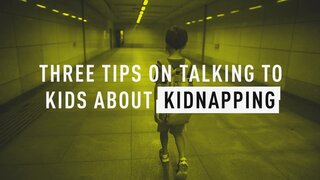Create a free profile to get unlimited access to exclusive videos, breaking news, sweepstakes, and more!
'Stranger Danger' Is Dead: How To Talk To Your Children About Kidnapping
Kidnapping is a rare occurence, but it still happens to families all over the country. Here's what you need to be teaching your children.
It's every parent's worst nightmare: a child vanishing without a trace. The idea leaves many parents shaking with anxiety — but when it comes to discussing the topic of kidnapping with your children, experts say parents shouldn't be paralyzed by fear.
Instead, parents should focus on turning safety conversations into empowering discussions that provide simple and clear messaging children of all ages can easily understand.
"Safety, when it's done right, isn't scary," Alison Feigh, program manager for the Jacob Wetterling Resource Center, a program of the Gunderson National Child Protection Training Center, told Oxygen.com. So what should you do to prepare your children?
What are the chances of your child being kidnapped?
Experts point out that it's important for parents to know that child abductions are extremely rare.
"Children encounter dangers in their lives, but somebody trying to abscond with them is relatively rare compared to being assaulted or being sexually abused," David Finkelhor, director of the Crimes Against Children Research Center at the University of New Hampshire, told Oxygen.com.
In fact, in the more than 27,000 cases of missing children that the National Center for Missing & Exploited Children (NCMEC) assisted law enforcement and families with in 2017, just 1% were categorized as non-family abductions and just 5% were considered family abductions, according to the organization's statistics.
But while the numbers do offer parents some peace of mind, child abductions still do occur.
Callahan Walsh, a child advocate for NCMEC, and his family know the danger firsthand. In 1981, Callahan's brother Adam was abducted from a Sears department store in Florida. He had been playing video games while his mom, Revé Walsh, shopped just a few aisles away. When she returned just a short time later, he was gone, according to Time Magazine.
"My parents back in 1981 were completely naive to the issue and my father was a successful business owner, he was building hotels, my mom was a stay-at-home mother," Walsh told Oxygen.com. "They had heard about this issue, but they thought it could never affect them."
Adam's case was one of the first to receive national attention, and although his body was found two weeks after he went missing, his parents, Revé and John Walsh, wanted to help other families who had lost children. They started the Adam Walsh Resource Center, which is now known as National Center for Missing & Exploited Children, from their garage with only a card table and phone line.
Callahan Walsh has adopted that same passion for child safety and has dedicated his career to protecting children and families from potential dangers.
"It's always a dangerous situation no matter how that child went missing, and that's why it's important for parents to understand the dangers that are out there, but empower their children to make those safe and smart decisions themselves, because a parent can't always be there," Walsh said.
"Stranger Danger" isn't really useful.
Many parents may remember learning all about the concept of "stranger danger" in classrooms themselves as young children, but experts say that's a message that no longer fully encompasses the risks to a child.
"'Stranger danger,' while it sounds easy to teach a child... it rhymes, it's a simple phrase... child safety is more nuanced than that," Walsh told Oxygen.com.
Statistically, a child is more likely to be abducted or harmed by someone they know, which means that only focusing messaging on strangers could give children a false sense of security around those they do know.
Teach your child the "check-first" rule.
One of the most important ways parents can help their children stay safe is to implement a "check-first" safety rule. Under this simple rule, children are taught that any time anyone is trying to get them to go somewhere, give them a present, or are asking for help, the child needs to first check with the parent or adult in charge.
"We don't go anywhere with anyone who doesn't let us check first," Feigh said, adding that parents should teach children to step back and make a "safety bubble" before going to check with a grown-up.
It's important, she said, that the rule is consistently enforced, even if the child knows or is comfortable with the person making the request.
"If Mom's friend drives up and says, 'Hey let's go get ice cream,' the rule is the same for anybody," Feigh said. "We move away from the car and check first."
Parents can help their children practice this rule by role playing potential situations that a child could end up in, whether it's with a stranger or acquaintance or neighbor. Feigh suggests avoiding using specific names of people if possible in role-playing scenarios.
According to Callahan, research into attempted abduction cases shows many of the lures used to entice children still remain the same — that includes asking for directions, asking for help searching for a lost pet, or offering free candy, money, or other items that may be tempting to a child. As a result, these type of scenarios are ideal situations to discuss or role play with your children.
NCMEC also has animated videos designed to teach kids important safety skills, including the check-first rule, on its Kidsmartz website.
Teach your child not to keep secrets.
It's important children know there is never any reason to keep a secret from a parent or guardian, Feigh noted. Keeping open lines of communication not only protects young children from potential sexual predators, it also establishes a healthy habit that will be valuable as the child reaches the teen years.
"If your child is asked to keep a secret, that is a red flag for them to leave the situation and talk to you immediately," reads one of the safety tips from the Jacob Wetterling Resource Center.
An important aspect of this is also teaching children that if someone does break one of their safety rules, the child has permission to tell and won't be in trouble, regardless of the child's actions or behavior.
"We do see kids who say, 'Well, someone did something to break my body safety rules and I didn't tell because I didn't do it right,'" Feigh said.
Finkelhor said parents need to stress to their children that they can come to them any time and that, as a parent, they will try not to get angry or make any judgments.
"It's this fear of being shamed and a parent getting angry that I think keeps them from talking about situations they may have gotten themselves into that are troubling," he said.
Encourage the use of the buddy system.
Most abductions occur between the hours of 2 p.m. and 7 p.m. when a child is walking alone, according to Walsh.
Experts said parents should encourage their children to take a friend or use the buddy system whenever they may be away from home or a group setting.
"Using the buddy system drastically cuts down the chances that they would be abducted," Walsh said.
Help your child identify trusted adults who are strangers.
As parents of young children know, it can be easy to lose sight of a child in a busy grocery store, ballpark, or other public venue. Walsh's brother Adam disappeared from a department store. For this reason, parents also need to regularly talk with their children about who may be someone they could trust, even if that person is a stranger.
"If something were to happen, even if your child were abducted by a stranger, it's likely that it's going to be another stranger that comes to their aid, and so it's really important for parents to talk to their kids about trusted adults and identifying who those are," Walsh explained.
Examples of other trusted adults could be a mother with kids, a police officer, or a store employee with a name tag.
Walsh said children need to know they should never go out to the parking lot if they are lost. He also recommends teaching children their phone number, their own full name, and their parent's full name from a young age in the event that a parent and child could be separated.
Create a circle of five trusted adults who are known to your child.
Statistically, most child abductions are done by someone known to the child. Often, these predators may try to isolate a child away from family and friends before an abduction or other form of abuse occurs. Feigh said parents should pay attention to people who seem to take a significant amount of interest in their child.
"Those abductions that happen, even if they are non-family, the number one lure isn't the lost puppy, and it isn't drugs, and it isn't candy... it's attention and affection," she said.
To prevent this, she recommends every child have a "safety net" of five grown-ups they can reach out to and talk to if they have a problem, especially as they get older and feel less comfortable coming to a parent.
"Healthy adults want to be one of many people supporting a kid, unhealthy adults try to separate them from their safety net. And so we want to pay attention to anyone who is trying to separate us from the adults who care about us," she said.
Teach kids how to respond in an abduction attempt.
Child abductions are rare, but experts said children should still know how to respond if someone does try to take them against their will.
In the event of an abduction attempt, children should drop whatever they have in their hands, make a lot of noise, and try to find an adult to help.
Feigh said she often talks with children about the distinction between yelling and screaming.
"When we hear screaming, we tend to move away from that," she said, adding that instead she encourages kids to yell from their gut and use phrases like "call 911" or other phrases that alert an adult that a child needs help.
Talk about safe technology practices.
As children grow, the biggest threats to their safety may be closer than parents realize — they're often found on their technological devices.
"While we are seeing less and less stranger abductions, we are seeing more exploitation of children online, and there's multiple new ways," Walsh explained.
To help parents navigate the unique challenges of online safety threats, NCMEC has a special online education program called Netsmartz, that has age-specific programming designed for kids of all ages.
As parents consider how to broach child safety and prevention with their children, experts say the best thing they can do is begin the conversation.
"If we are doing safety right, the parents feel empowered by the conversations, the kids feel empowered by the conversations," Feigh said. "It's positive."
[Photo: Getty]





























